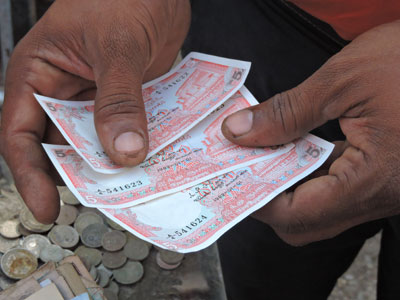Truth about defaced currency notes
The Central Bank of Sri Lanka (CB) recently adopted a clean note policy which has caused some anxiety among the public. Originally it was to come into effect on December 31, 2017 but then it was postponed indefinitely.

File picture of some old, 5-rupee currency notes
With an effective campaign which had CB adverts at every cash counter, the public have been made to understand that any ink on the currency note is not acceptable. I was once held up in a supermarket queue with the customer arguing with the counter clerk about a Rs. 5000 note with ink. When I tendered an old Rs. 20 note to the Railway ticket counter it was returned to me with the statement; “Don’t you know that banks don’t accept even a little ink”.
An independent check on a bundle of 1000 notes from a bank showed that about 5 per cent of notes in circulation have some ink. Mostly from lazy cashiers who sign or write a total directly on the note, rather than a slip of paper. I have been also told of significant defacement notes with a political image. Any collector of Ceylon currency notes would have seen notes with multiple post marks stamped by post offices, before around 1970. It is an old habit which CB is trying to break.
In mid-March when I was given 50 high denomination notes from a bank teller, I decided to check and found that three of the notes had ink, and I had them replaced. I was told that the counting machines at the bank had been calibrated to CB guidelines, and if it went through the machine it was OK. I was clearly intrigued when they informed me of a document sent by the CB to LCBs (local commercial banks) with specifications. There was clearly a difference between what the public understood and what was legally acceptable. I found a Sinhala video online on how to remove ink from Currency Notes using a stain remover. Social Media was seeking solutions.
On March 19 I submitted to the CB a RTI request to find out the specific details which had not been issued to public. On March 29 the CB put advertisements in all the major newspapers saying “currency notes have been mistakenly marked in the form of a small dot or a line are not considered as willfully mutilated”. The same day a CB press release said; “CBSL has decided to continue the service of exchange of willfully mutilated, altered and defaced currency notes from CBSL until further notice.” The public were informed to submit such currency notes to the few CB offices or send the same by registered post together with a duly completed application form.
However the Sri Lanka Post office website says “Currency notes may be sent in registered letters, the insurance of which is compulsory.” The post office has discontinued rarely used postal insurance back in 2007. The PMG has informed me, that SLPost is now talking with the CB to resolve this issue. I am not sure why the more extensive branch network of LCBs as a customer service can’t be instructed to accept the notes with the CB form, accumulate and forward to CB through bank channels. Else who will pay the costs of postage, registration and insurance, both ways?
Finally after seven weeks, although it was acknowledged to send a reply in two weeks, I got a reply on May 9 to my RTI with the statement that: “The parameter/guidelines issued to LCBs to calibrate currency processing machines to detect willfully mutilated, altered and defaced currency notes is given below:
a. Currency notes defaced with drawings, words, numbers, signs or symbols where the serial number, date, signature, value, or security feature of the currency note has been altered in any significant way and/or;
b. Willfully mutilation, alteration and defacement in the currency note exceeds the below area: All Denominations. In Watermark Area 10 x 10 mm. In Printed area 15 x 15 mm
Clearly that amount of defacement is rarely seen on currency notes and I was relieved that more than a “small dot or a line” will be accepted by LCB counting machines.
Thus I don’t need to look carefully through all the notes I get from a Cash Teller or ATM. Although that maybe a safe practice as a close friend informed me that he got a fake Rs 1000 note from a Bank ATM, and only discovered when it was declined at a local shop. That is lot worse than getting defaced currency.


